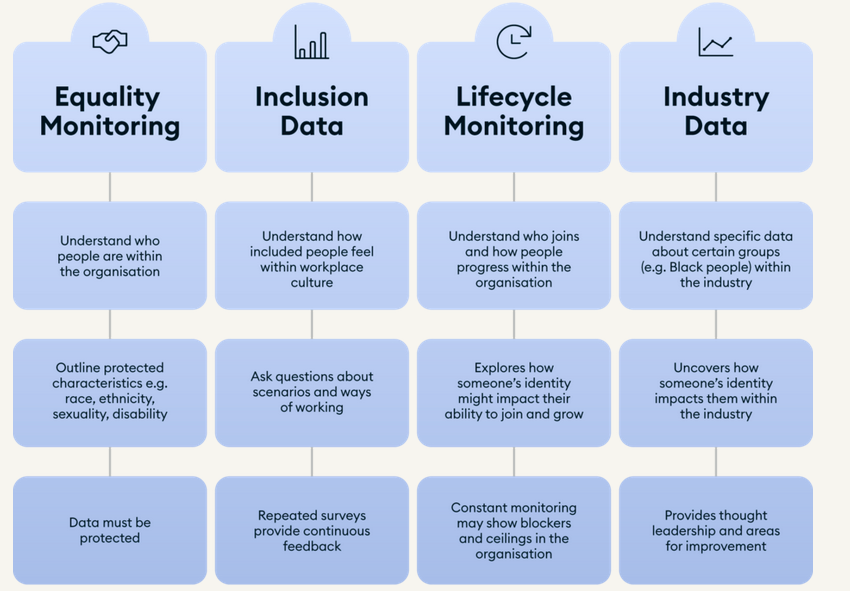To ensure that we are genuinely recruiting and awarding opportunities for development and promotion based on merit, organisations must start with data and employ the right metrics to benchmark, track and hold people to account.
Employer recommendations
"No company’s commitment to diversity and inclusion can be taken seriously until it collects, scrutinises and is transparent with its data."
Race in the Workplace, McGregor-Smith Review 2017
➖Begin by reading the Tech Talent Charter guide to ‘Collecting Diversity and Inclusion Data’.
➖Establish your organisation's existing D&I experience, performance, culture and maturity baseline by using quality people data, metrics and analytics from your HR Information System (HRIS) and employee experience feedback from employee surveys and listening mechanisms.
➖When collecting D&I data, you must communicate clear FAQs to employees to encourage them to provide their personal data including:
- How self-identification data supports the organisation’s D&I commitments. Share what decisions the data will inform. The more concrete examples you can include on how the information will be used, the more likely that more people will choose to disclose their demographic data.
- How a person's data will be protected and stored, and who will have access to the information.
- If individuals will be identifiable from the data and if the information will be stored separately from personal details.
- How individuals can opt out.
- Senior leaders personal views on why collecting data is important to them and to the organisation.
➖Encourage people who do not want to provide their data to still complete the census and choose the 'prefer not to say' option so the organisation is clear on those people who don't want to provide their data vs those people you haven't reached to complete the census. [Listen to Asif Sadiq MBE, Chief Diversity, Equity, and Inclusion Officer for Warner Brothers Discovery talk about this in this podcast].
➖Engage with your workforce to understand the preferred and most appropriate language for your company, across all areas of diversity – ensuring that terms connect clearly to best practice.
➖Have senior leaders build the importance of having self-ID diversity data into all speaking opportunities with their people including how aggregated data will be used to improve the employee experience (for everyone) and why the exercise is personally important to them.
➖Check that line managers truly understand the why and what will be done with aggregated self-ID data so this information is correctly disseminated to their team. For example, explain ‘Without the data we are unable to calculate our ethnicity pay gap or measure the progress we are making with our inclusion action plan’.
➖Report self-ID completion rates by business unit on a monthly/quarterly basis to encourage competition among leaders.
➖Make the self-ID platform accessible to all employees.
➖Automatically prompt employees who haven't submitted a response to self ID campaigns encouraging them to respond while also reminding them they can respond to the survey with a 'prefer not to say'.
➖Use #CountMeIn on social media channels to promote your Self-ID campaign and encourage colleagues to post and use the hashtag when they have updated their data.
Examples of company self-ID campaigns:- Santander focused on making its disclosure rate campaign as targeted as possible by holding workshops with employees to understand what is holding them back from disclosing their ethnicity.
- Shell centered its campaign around their diversity and inclusion day – during which they organise discussions on ethnicity and share videos of senior leaders explaining why sharing informationabout ethnicity is important.
- PwC launched a company-wide communications campaign called “who do we think you are?” to encourage employees to share their personal data, explaining why they were being asked to provide this information and how the data would be used.
- Many organisations now use #CountMeIn on social media channels to promote their Self-ID campaign and colleagues are encouraged to post and use the hashtag when they have updated their data.
Tech Nation have helpfully broken down the different types of D&I data into a diagram:

Further information
- Article: 50+ Examples of DEI Scorecards and DEI Reports
- Guide: Diversity Data. PwC and Investment Association, 2021
- Guide: Capturing data on sexual orientation and gender identity globally. Stonewall.
- Form: Example diversity monitoring form. ACAS
- Form: Equal opportunities recruitment monitoring. CIPD
- Article: Best practices for self identification. Disability:IN, 2022
- Guide: Diversity Collection Toolkit. Lloyd's, 2022
- Guide: How to set effective targets. Behavioural insights, 2021
- Video: D&I data disclosure, Signatory Forum 2023
- Guide: Collecting ethnicity data, Gov.uk
- Guide: 5 steps to building your first Diversity & Inclusion Report, Culture Amp
- Resource: Diversity, Equity and Inclusion Metrics to Track and Report, Gartner
